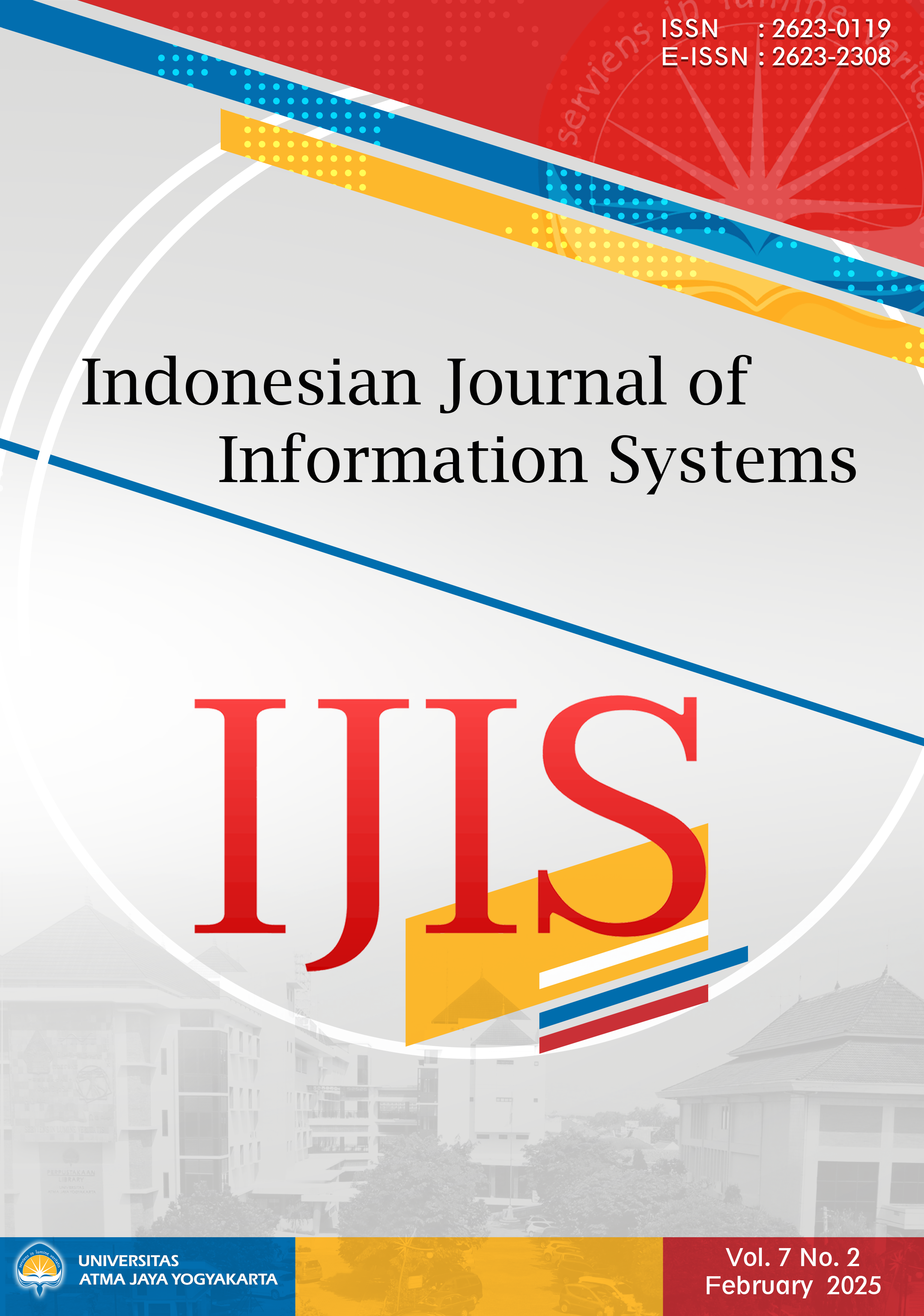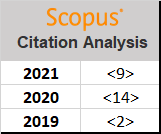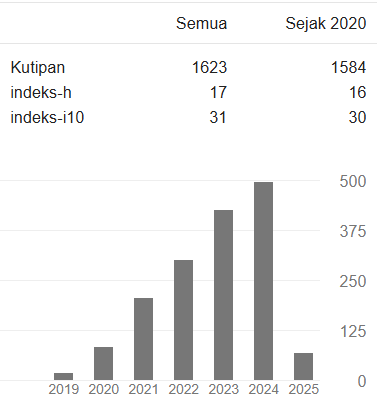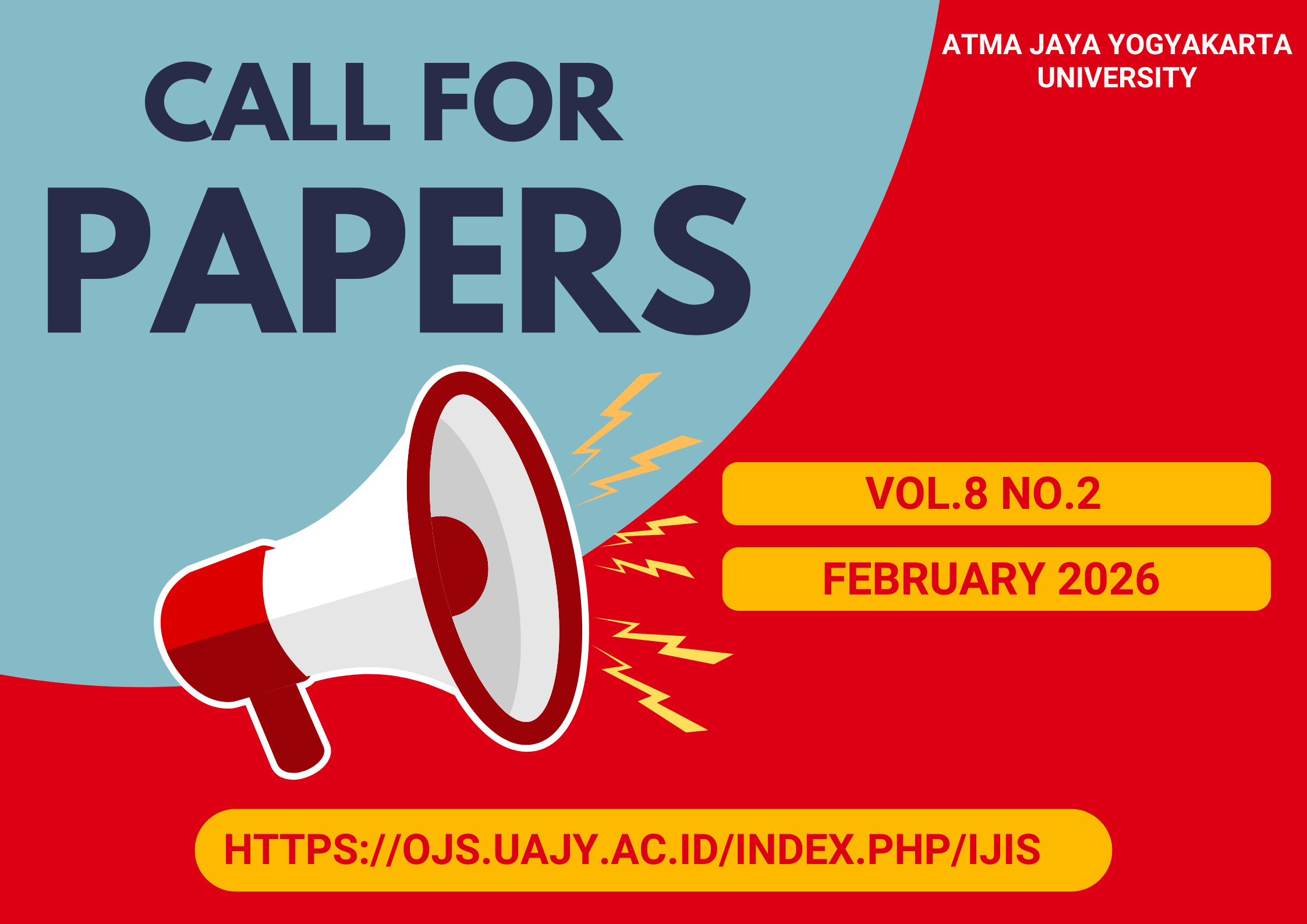Improved Banking Customer Retention Prediction Based on Advanced Machine Learning Models
DOI:
https://doi.org/10.24002/ijis.v7i2.10364Abstract
The quick growth of the banking sector is reflected in the rise in the number of banks. In addition to the intense competition among banks for new customers, efforts to keep existing ones are essential to minimizing potential losses for the company. To ascertain whether customers will leave the bank or remain customers, this study will employ churn forecasts. A 1,750,036-customer demographic dataset, which includes data on bank customers who have left or are still customers, is used in the training process to compare five machine learning technology models in order to investigate the improvement of binary classification prediction accuracy. These models are Decision Tree, Random Forest, Gradient Boost, Cat Boost, and Light Gradient Boosting Machine (LGBM). According to the study's results, LGBM performs better than the other four models since it has the highest recall and accuracy and the fewest False Negatives. The LGBM model's corresponding accuracy, precision, recall, f1 score, and AUC are 0.8789, 0.8978, 0.8553, 0.8758, and 0.9694. This demonstrates that, in comparison to traditional methods, machine learning optimization can produce notable advantages in churn risk classification. This study offers compelling proof that sophisticated machine learning modeling can revolutionize banking industry client retention management.
References
[1] Byline, “Retail banking costs are rising on multiple fronts, increasing cost to serve,” 2024. [Online]. Available: https://www.mckinsey.com/industries/financial-services/our-insights/the-state-of-retail-banking-profitability-and-growth-in-the-era-of-digital-and-ai
[2] J. Marous, “The Importance of Primacy in Banking,” The Financial Brand, 2024. https://thefinancialbrand.com/news/bank-onboarding/the-importance-of-primacy-in-banking-176198
[3] Deloitte, “Kicking it up a notch Taking retail bank cross-selling to the next level.” [Online]. Available: https://www2.deloitte.com/content/dam/Deloitte/us/Documents/financial-services/us-kickingitupanotch-092614.pdf
[4] T. P. Chi, N. Van Hoa, P. Van Thu, N. A. Tuan, and H. T. Nguyen, “Customer Experience Management in Retail Business : A Theoretical Debate,” vol. 4, no. 5, pp. 854–863, 2024.
[5] R. Yulianto, M. S. Rusli, A. Satyo, B. Karno, W. Hastomo, and A. R. Kardian, “Innovative UNET-Based Steel Defect Detection Using 5 Pretrained Models Innovative UNET-Based Steel Defect Detection Using 5 Pretrained Models,” vol. 10, no. 4, pp. 2365–2378, 2023.
[6] S. Gao, F. Huang, W. Cai, and H. Huang, “Network pruning via Performance Maximization,” Proc. IEEE Comput. Soc. Conf. Comput. Vis. Pattern Recognit., pp. 9266–9276, 2021, doi: 10.1109/CVPR46437.2021.00915.
[7] F. E. Usman-Hamza et al., “Empirical analysis of tree-based classification models for customer churn prediction,” Sci. African, vol. 23, p. e02054, 2024, doi: https://doi.org/10.1016/j.sciaf.2023.e02054.
[8] E. Domingos, B. Ojeme, and O. Daramola, “Experimental Analysis of Hyperparameters for Deep Learning-Based Churn Prediction in the Banking Sector,” Computation, vol. 9, no. 3. 2021. doi: 10.3390/computation9030034.
[9] W. Hastomo, A. S. Bayangkari Karno, N. Kalbuana, A. Meiriki, and Sutarno, “Characteristic Parameters of Epoch Deep Learning to Predict Covid-19 Data in Indonesia,” J. Phys. Conf. Ser., vol. 1933, no. 1, 2021, doi: 10.1088/1742-6596/1933/1/012050.
[10] A. H. Victoria and G. Maragatham, “Automatic tuning of hyperparameters using Bayesian optimization,” Evol. Syst., vol. 12, no. 1, pp. 217–223, 2021, doi: 10.1007/s12530-020-09345-2.
[11] A. M. Carrington et al., “Deep ROC Analysis and AUC as Balanced Average Accuracy, for Improved Classifier Selection, Audit and Explanation,” IEEE Trans. Pattern Anal. Mach. Intell., vol. 45, no. 1, pp. 329–341, 2023, doi: 10.1109/TPAMI.2022.3145392.
[12] A. S. B. Karno et al., “Classification of cervical spine fractures using 8 variants EfficientNet with transfer learning,” Int. J. Electr. Comput. Eng., vol. 13, no. 6, pp. 7065–7077, 2023, doi: 10.11591/ijece.v13i6.pp7065-7077.
[13] S. Farhadpour, T. A. Warner, and A. E. Maxwell, “Selecting and Interpreting Multiclass Loss and Accuracy Assessment Metrics for Classifications with Class Imbalance: Guidance and Best Practices,” Remote Sensing, vol. 16, no. 3. 2024. doi: 10.3390/rs16030533.
[14] P. Gupta, A. Varshney, M. R. Khan, R. Ahmed, M. Shuaib, and S. Alam, “Unbalanced Credit Card Fraud Detection Data: A Machine Learning-Oriented Comparative Study of Balancing Techniques,” Procedia Comput. Sci., vol. 218, pp. 2575–2584, 2023, doi: https://doi.org/10.1016/j.procs.2023.01.231.
[15] C. Vuppalapati, “Data Engineering and Exploratory Data Analysis Techniques,” in Machine Learning and Artificial Intelligence for Agricultural Economics: Prognostic Data Analytics to Serve Small Scale Farmers Worldwide, Cham: Springer International Publishing, 2021, pp. 75–158. doi: 10.1007/978-3-030-77485-1_2.
[16] E. 1 Playground Series - Season 4, “Binary Classification with a Bank Churn Dataset,” kaggle.com, 2024. https://kaggle.com/competitions/playground-series-s4e1 (accessed Mar. 05, 2024).
[17] K. P. N. V Satya Sree, J. Karthik, C. Niharika, P. V. V. S. Srinivas, N. Ravinder, and C. Prasad, “Optimized Conversion of Categorical and Numerical Features in Machine Learning Models,” in 2021 Fifth International Conference on I-SMAC (IoT in Social, Mobile, Analytics and Cloud) (I-SMAC), 2021, pp. 294–299. doi: 10.1109/I-SMAC52330.2021.9640967.
[18] M. K. Dahouda and I. Joe, “A Deep-Learned Embedding Technique for Categorical Features Encoding,” IEEE Access, vol. 9, pp. 114381–114391, 2021, doi: 10.1109/ACCESS.2021.3104357.
[19] S. Dasari and R. Kaluri, “An Effective Classification of DDoS Attacks in a Distributed Network by Adopting Hierarchical Machine Learning and Hyperparameters Optimization Techniques,” IEEE Access, vol. 12, pp. 10834–10845, 2024, doi: 10.1109/ACCESS.2024.3352281.
[20] S. Boeschoten, C. Catal, B. Tekinerdogan, A. Lommen, and M. Blokland, “The automation of the development of classification models and improvement of model quality using feature engineering techniques,” Expert Syst. Appl., vol. 213, p. 118912, 2023, doi: https://doi.org/10.1016/j.eswa.2022.118912.
[21] M. S. Ali, M. K. Islam, A. A. Das, D. U. S. Duranta, M. F. Haque, and M. H. Rahman, “A Novel Approach for Best Parameters Selection and Feature Engineering to Analyze and Detect Diabetes: Machine Learning Insights,” Biomed Res. Int., vol. 2023, no. 1, p. 8583210, Jan. 2023, doi: https://doi.org/10.1155/2023/8583210.
[22] D. Singh and B. Singh, “Feature wise normalization: An effective way of normalizing data,” Pattern Recognit., vol. 122, p. 108307, 2022, doi: https://doi.org/10.1016/j.patcog.2021.108307.
[23] I. H. Sarker, “Machine Learning: Algorithms, Real-World Applications and Research Directions,” SN Comput. Sci., vol. 2, no. 3, p. 160, 2021, doi: 10.1007/s42979-021-00592-x.
[24] M. A. Ganaie, M. Hu, A. K. Malik, M. Tanveer, and P. N. Suganthan, “Ensemble deep learning: A review,” Eng. Appl. Artif. Intell., vol. 115, p. 105151, 2022, doi: https://doi.org/10.1016/j.engappai.2022.105151.
[25] M. Bansal, A. Goyal, and A. Choudhary, “A comparative analysis of K-Nearest Neighbor, Genetic, Support Vector Machine, Decision Tree, and Long Short Term Memory algorithms in machine learning,” Decis. Anal. J., vol. 3, p. 100071, 2022, doi: https://doi.org/10.1016/j.dajour.2022.100071.
[26] D. Chicco, L. Oneto, and E. Tavazzi, “Eleven quick tips for data cleaning and feature engineering,” PLOS Comput. Biol., vol. 18, no. 12, p. e1010718, Dec. 2022, [Online]. Available: https://doi.org/10.1371/journal.pcbi.1010718
[27] L. Wang, M. Han, X. Li, N. Zhang, and H. Cheng, “Review of Classification Methods on Unbalanced Data Sets,” IEEE Access, vol. 9, pp. 64606–64628, 2021, doi: 10.1109/ACCESS.2021.3074243.
[28] L. Barreñada, P. Dhiman, D. Timmerman, A.-L. Boulesteix, and B. Van Calster, “Understanding overfitting in random forest for probability estimation: a visualization and simulation study,” Diagnostic Progn. Res., vol. 8, no. 1, p. 14, 2024, doi: 10.1186/s41512-024-00177-1.
[29] A. V Konstantinov and L. V Utkin, “Interpretable machine learning with an ensemble of gradient boosting machines,” Knowledge-Based Syst., vol. 222, p. 106993, 2021, doi: https://doi.org/10.1016/j.knosys.2021.106993.
[30] M. Hajihosseinlou, A. Maghsoudi, and R. Ghezelbash, “A Novel Scheme for Mapping of MVT-Type Pb–Zn Prospectivity: LightGBM, a Highly Efficient Gradient Boosting Decision Tree Machine Learning Algorithm,” Nat. Resour. Res., vol. 32, no. 6, pp. 2417–2438, 2023, doi: 10.1007/s11053-023-10249-6.
[31] M. Luo et al., “Combination of Feature Selection and CatBoost for Prediction: The First Application to the Estimation of Aboveground Biomass,” Forests, vol. 12, no. 2. 2021. doi: 10.3390/f12020216.
[32] C. Li et al., “Machine learning based early mortality prediction in the emergency department,” Int. J. Med. Inform., vol. 155, p. 104570, 2021, doi: https://doi.org/10.1016/j.ijmedinf.2021.104570.
[33] S. Lee, T. P. Vo, H.-T. Thai, J. Lee, and V. Patel, “Strength prediction of concrete-filled steel tubular columns using Categorical Gradient Boosting algorithm,” Eng. Struct., vol. 238, p. 112109, 2021, doi: https://doi.org/10.1016/j.engstruct.2021.112109.
[34] G. Ke et al., “LightGBM: A Highly Efficient Gradient Boosting Decision Tree,” in Advances in Neural Information Processing Systems, 2017, vol. 30. [Online]. Available: https://proceedings.neurips.cc/paper_files/paper/2017/file/6449f44a102fde848669bdd9eb6b76fa-Paper.pdf
[35] L. Prokhorenkova, G. Gusev, A. Vorobev, A. V. Dorogush, and A. Gulin, “CatBoost: unbiased boosting with categorical features,” in Advances in Neural Information Processing Systems, 2018, vol. 31. [Online]. Available: https://proceedings.neurips.cc/paper_files/paper/2018/file/14491b756b3a51daac41c24863285549-Paper.pdf
[36] Z. Rahmatinejad et al., “A comparative study of explainable ensemble learning and logistic regression for predicting in-hospital mortality in the emergency department,” Sci. Rep., vol. 14, no. 1, p. 3406, 2024, doi: 10.1038/s41598-024-54038-4.
[37] C. Bentéjac, A. Csörgő, and G. Martínez-Muñoz, “A comparative analysis of gradient boosting algorithms,” Artif. Intell. Rev., vol. 54, no. 3, pp. 1937–1967, 2021, doi: 10.1007/s10462-020-09896-5.
[38] S. Jeong, J. Ko, and J.-M. Yeom, “Predicting rice yield at pixel scale through synthetic use of crop and deep learning models with satellite data in South and North Korea,” Sci. Total Environ., vol. 802, p. 149726, 2022, doi: https://doi.org/10.1016/j.scitotenv.2021.149726.
[39] Z. Li and D. Hu, “Forecast of the COVID-19 Epidemic Based on RF-BOA-LightGBM,” Healthcare, vol. 9, no. 9. 2021. doi: 10.3390/healthcare9091172.
[40] H. Zhang et al., “High-Resolution Vegetation Mapping Using eXtreme Gradient Boosting Based on Extensive Features,” Remote Sens., vol. 11, no. 12, 2019, doi: 10.3390/rs11121505.
Downloads
Published
How to Cite
Issue
Section
License

This work is licensed under a Creative Commons Attribution-ShareAlike 4.0 International License.
Indonesian Journal of Information Systems as journal publisher holds copyright of papers published in this journal. Authors transfer the copyright of their journal by filling Copyright Transfer Form and send it to Indonesian Journal of Information Systems.

Indonesian Journal of Information Systems is licensed under a Creative Commons Attribution-NonCommercial 4.0 International License.

















